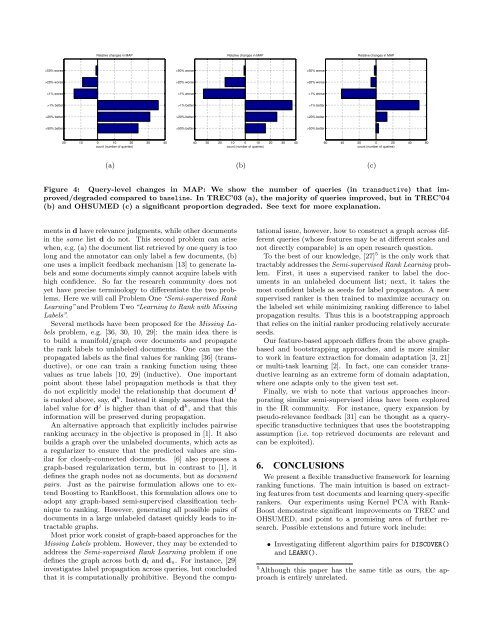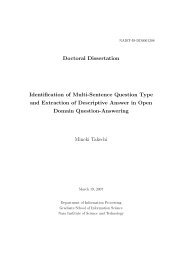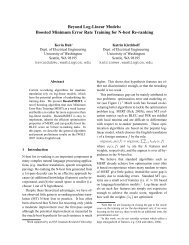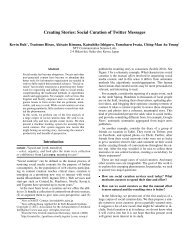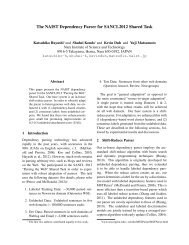Learning to Rank with Partially-Labeled Data - University of ...
Learning to Rank with Partially-Labeled Data - University of ...
Learning to Rank with Partially-Labeled Data - University of ...
Create successful ePaper yourself
Turn your PDF publications into a flip-book with our unique Google optimized e-Paper software.
Relative changes in MAP<br />
Relative changes in MAP<br />
Relative changes in MAP<br />
>50% worse<br />
>50% worse<br />
>50% worse<br />
>20% worse<br />
>20% worse<br />
>20% worse<br />
>1% worse<br />
>1% worse<br />
>1% worse<br />
>1% better<br />
>1% better<br />
>1% better<br />
>20% better<br />
>20% better<br />
>20% better<br />
>50% better<br />
>50% better<br />
>50% better<br />
20 10 0 10 20 30 40<br />
count (number <strong>of</strong> queries)<br />
40 30 20 10 0 10 20 30 40<br />
count (number <strong>of</strong> queries)<br />
60 40 20 0 20 40 60<br />
count (number <strong>of</strong> queries)<br />
(a)<br />
(b)<br />
(c)<br />
Figure 4: Query-level changes in MAP: We show the number <strong>of</strong> queries (in transductive) that improved/degraded<br />
compared <strong>to</strong> baseline. In TREC’03 (a), the majority <strong>of</strong> queries improved, but in TREC’04<br />
(b) and OHSUMED (c) a significant proportion degraded. See text for more explanation.<br />
ments in d have relevance judgments, while other documents<br />
in the same list d do not. This second problem can arise<br />
when, e.g. (a) the document list retrieved by one query is <strong>to</strong>o<br />
long and the annota<strong>to</strong>r can only label a few documents, (b)<br />
one uses a implicit feedback mechanism [13] <strong>to</strong> generate labels<br />
and some documents simply cannot acquire labels <strong>with</strong><br />
high confidence. So far the research community does not<br />
yet have precise terminology <strong>to</strong> differentiate the two problems.<br />
Here we will call Problem One “Semi-supervised <strong>Rank</strong><br />
<strong>Learning</strong>” and Problem Two “<strong>Learning</strong> <strong>to</strong> <strong>Rank</strong> <strong>with</strong> Missing<br />
Labels”.<br />
Several methods have been proposed for the Missing Labels<br />
problem, e.g. [36, 30, 10, 29]: the main idea there is<br />
<strong>to</strong> build a manifold/graph over documents and propagate<br />
the rank labels <strong>to</strong> unlabeled documents. One can use the<br />
propagated labels as the final values for ranking [36] (transductive),<br />
or one can train a ranking function using these<br />
values as true labels [10, 29] (inductive). One important<br />
point about these label propagation methods is that they<br />
do not explicitly model the relationship that document d j<br />
is ranked above, say, d k . Instead it simply assumes that the<br />
label value for d j is higher than that <strong>of</strong> d k , and that this<br />
information will be preserved during propagation.<br />
An alternative approach that explicitly includes pairwise<br />
ranking accuracy in the objective is proposed in [1]. It also<br />
builds a graph over the unlabeled documents, which acts as<br />
a regularizer <strong>to</strong> ensure that the predicted values are similar<br />
for closely-connected documents. [6] also proposes a<br />
graph-based regularization term, but in contrast <strong>to</strong> [1], it<br />
defines the graph nodes not as documents, but as document<br />
pairs. Just as the pairwise formulation allows one <strong>to</strong> extend<br />
Boosting <strong>to</strong> <strong>Rank</strong>Boost, this formulation allows one <strong>to</strong><br />
adopt any graph-based semi-supervised classification technique<br />
<strong>to</strong> ranking. However, generating all possible pairs <strong>of</strong><br />
documents in a large unlabeled dataset quickly leads <strong>to</strong> intractable<br />
graphs.<br />
Most prior work consist <strong>of</strong> graph-based approaches for the<br />
Missing Labels problem. However, they may be extended <strong>to</strong><br />
address the Semi-supervised <strong>Rank</strong> <strong>Learning</strong> problem if one<br />
defines the graph across both d l and d u. For instance, [29]<br />
investigates label propagation across queries, but concluded<br />
that it is computationally prohibitive. Beyond the computational<br />
issue, however, how <strong>to</strong> construct a graph across different<br />
queries (whose features may be at different scales and<br />
not directly comparable) is an open research question.<br />
To the best <strong>of</strong> our knowledge, [27] 5 is the only work that<br />
tractably addresses the Semi-supervised <strong>Rank</strong> <strong>Learning</strong> problem.<br />
First, it uses a supervised ranker <strong>to</strong> label the documents<br />
in an unlabeled document list; next, it takes the<br />
most confident labels as seeds for label propaga<strong>to</strong>n. A new<br />
supervised ranker is then trained <strong>to</strong> maximize accuracy on<br />
the labeled set while minimizing ranking difference <strong>to</strong> label<br />
propagation results. Thus this is a bootstrapping approach<br />
that relies on the initial ranker producing relatively accurate<br />
seeds.<br />
Our feature-based approach differs from the above graphbased<br />
and bootstrapping approaches, and is more similar<br />
<strong>to</strong> work in feature extraction for domain adaptation [3, 21]<br />
or multi-task learning [2]. In fact, one can consider transductive<br />
learning as an extreme form <strong>of</strong> domain adaptation,<br />
where one adapts only <strong>to</strong> the given test set.<br />
Finally, we wish <strong>to</strong> note that various approaches incorporating<br />
similar semi-supervised ideas have been explored<br />
in the IR community. For instance, query expansion by<br />
pseudo-relevance feedback [31] can be thought as a queryspecific<br />
transductive techniques that uses the bootstrapping<br />
assumption (i.e. <strong>to</strong>p retrieved documents are relevant and<br />
can be exploited).<br />
6. CONCLUSIONS<br />
We present a flexible transductive framework for learning<br />
ranking functions. The main intuition is based on extracting<br />
features from test documents and learning query-specific<br />
rankers. Our experiments using Kernel PCA <strong>with</strong> <strong>Rank</strong>-<br />
Boost demonstrate significant improvements on TREC and<br />
OHSUMED, and point <strong>to</strong> a promising area <strong>of</strong> further research.<br />
Possible extensions and future work include:<br />
• Investigating different algorthim pairs for DISCOVER()<br />
and LEARN().<br />
5 Although this paper has the same title as ours, the approach<br />
is entirely unrelated.


